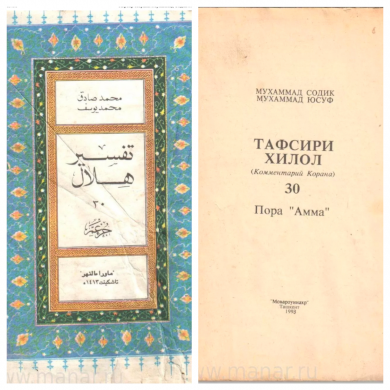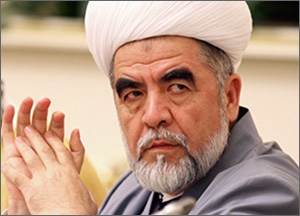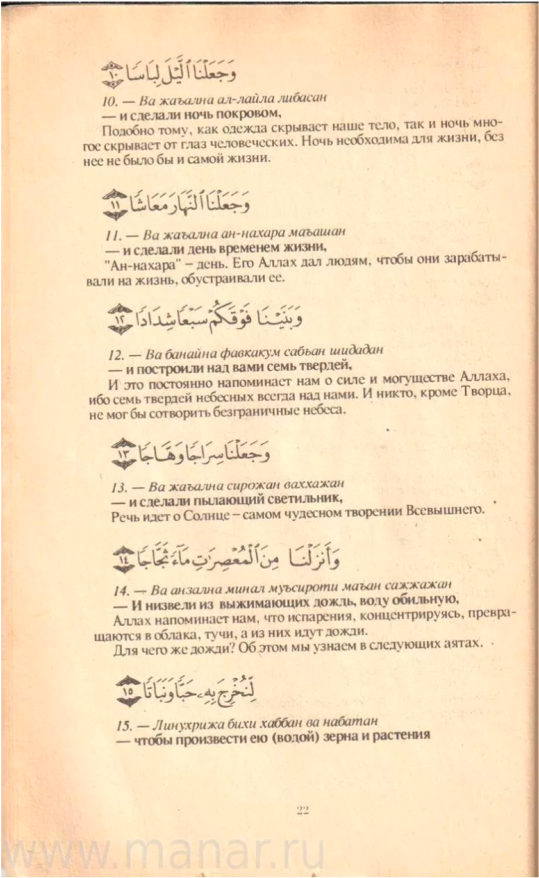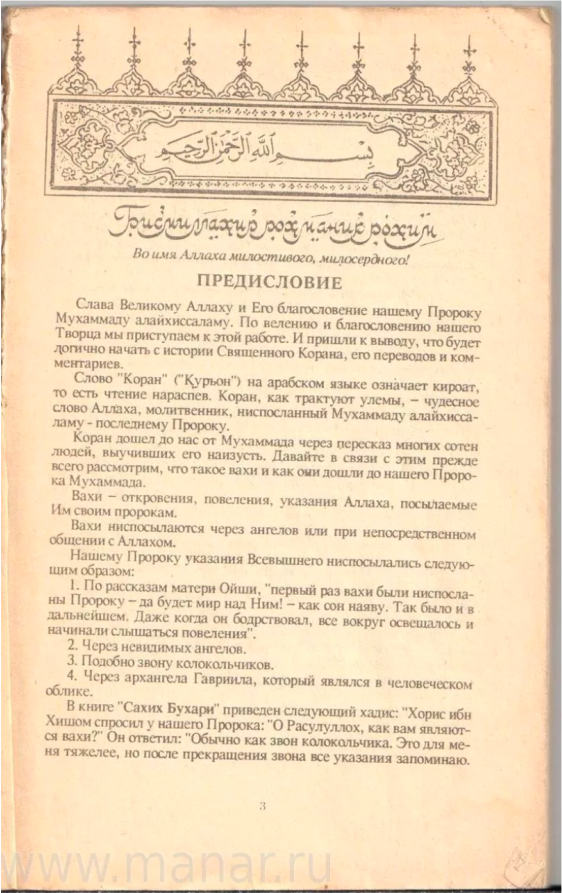This week we present one of the very first tafsīr translations into Russian to be published after the official collapse of the USSR. ‘Tafsīr Hilal’ (Hilol), by Shaykh Muhammad Sodiq Muhammad Yusuf (d. 2015), was originally written in Uzbek and has been both partially and fully translated into some of the languages of the region. Sodiq was a very influential religious figure and many of his students became key Muslim clerics across post-Soviet spaces, including in Russia itself.
His biography was quite extraordinary for a Soviet Muslim scholar and deserves a separate post. Suffice to say, he was born into a family of Uzbek ʿulamāʾ and studied Islam in Soviet institutions such as Mir-i Arab Madrasa in Bukhara,as well as abroad in Libya – which was rare luck for one living under the Iron Curtain. He established a successful career for himself during the Soviet period, becoming the last Mufti of the Muslim Spiritual Administration of Central Asia (SADUM), and even embarking on a political career at the end of the Soviet Union by participating in legislative elections. During the early years of independence, Sodiq became the chief Mufti of Uzbekistan for a short period, but was forced into in exile in 1993 as a result of his endeavors to retain a level of institutional religious autonomy in Uzbekistan. Sodiq’s views clashed with those promoted by the authoritarian and repressive regime of the first president of Uzbekistan, Islam Karimov (d. 2016), who viewed him as a potential threat due to his national popularity and natural charisma (although the official state narrative gives a different view). He was only able to permanently return to his homeland in 2001, when Karimov changed his attitude towards him. Sodiq’s return to Uzbekistan as a charismatic ally of the existing authorities allowed him to have a media presence, and to preach and publish extensively.
Sodiq was a prolific writer on a range of topics, including Islamic piety, tafsīr, the Muslim family, and Ḥanafī fiqh. He is perhaps best known for his ‘Tafsīr Hilal,’ which was recently (in 2020) translated into Russian in full in a ten-volume edition. This post, however, does not address this recent edition, but will instead briefly introduce some features of an earlier translation published in 1993 by the Movarounnahr publishing house in Tashkent. Movarounnahr published a Russian translation of the section of ‘Tafsīr Hilal’ that deals with the jūzʾ ʿamma, the last part of the Qur’an, which is traditionally frequently read and memorized by Muslims. Contemporaries testify that the timing of this publication, which was produced amidst the ruins of the USSR soon after its collapse, significantly contributed to the dissemination of the Qur’an and its tafsīr at a grassroots level.
Sodiq’s tafsīr published by the Movarounnahr edition includes rich additional introductory information about key Muslim concepts related to the revelation such as waḥy (revelation), some sections of the Sīra nabawiyya (the Biography of the Prophet) that pertain to the Qur’an, and the history of the compilation of the Muslim scripture. Such information was intended to familiarize the reader with the most important prerequisite information about Islam. It also contains a section dedicated to the miracles of the Qur’an that discusses modern scientific discoveries and the clues about these that can be found in the Qur’an, which aims to persuade or strengthen the faith of those inclined to scientific explanations and ‘tangible’ proofs. Particularly significant is the way the author reinforces a sense of national esteem for the ‘golden Muslim past’ of the region by referring to famous premodern scholars from Transoxiana and neighboring regions such as, for example, al-Zamakhsharī, al-Māturīdī and al-Nasafī. This stress on the ‘national heroes’ of exegesis is an important trope that is intended to connect the Sovietized masses with these medieval authors and create new identities in line with the Islamic past. The edition contains no straightforward critique of the Soviet period, which might be understood as a strategic avoidance on Sodiq’s part, due to the ambiguity of the political landscape in the early 1990s when the collapse of the Soviet bloc had only just taken place. Another reason might be that since the intended audience of the book, which is in Russian, reaches beyond his own compatriots, Sodiq strived to smooth any possible resentments and tensions, since perceptions of Soviet history might vary. Thus, although he sadly notes the loss of religious literacy, the abandonment of Arabic script, and the rupture of continuity of tradition, and laments the glorious past of Mawarannahr, his only comment is that ‘this is just how things happened’. This might be viewed as a strategic move intended to circumvent any possible criticism and controversy, a lesson learned while working under pressure from the Soviet authorities.
The ‘Tafsīr Hilal’ itself is written in simple and accessible language, suitable for a wide and non-specialist readership. It includes the original Arabic text of the Qur’an and a Russian translation, Cyrillic transcription, and a short tafsīr that is devoid of scholastic discussions and is practically oriented. In this early edition, the Qur’an translation was not authored by Sodiq himself but was taken from a previous translation by the Soviet Orientalist Ignaty Krachkovsky (d. 1951), but the use of Krachkovsky’s translation is not acknowledged and his name does not appear on any page of this publication.
This probably reflects the fact that the boom in Muslim Qur’an translation that took place to satisfy the demands of the religious revival that began in roughly the last decade of the USSR was not yet in motion, and the whole discourse about the criteria and standards of how to translate the Qur’an and who should translate it was not yet a subject of public debate. In later editions of ‘Tafsīr Hilal,’ existing Qur’an translations into Russian would be problematized and their use in this tafsīr would be rethought, with author/translators comparing the existing options and adopting them using a more critical approach. We can see this, for example, in the later edition of the ‘Tafsīr’ published by ‘Sharq’ in 2012, also in Tashkent. In this early edition, however, Krachkovsky appears as an anonymous intertext in Sodiq’s tafsīr, spanning the two epochs of the Soviet and post-Soviet, and hinting at an interconnectedness between the academic and confessional approaches.
The Movarounnahr edition is also distinguished by its transliteration system, which is very idiosyncratic and unusual to a contemporary reader: while Krachkovsky’s translation was adopted verbatim, the accustomed transliteration was not used. Instead, Sodiq used his own peculiar style of writing Islamic names and terms, which largely corresponds to Uzbek pronunciation. For example, Ibodat (ʿibāda); rasululloh (Allāh), olamin (ʿālamīn), Оysha (ʿĀʾisha), Usmon (ʿUthmān).
This transliteration system did not take root and was revised in subsequent editions; however, it is quite remarkable in that it illustrates how the combination of three languages (Arabic, Uzbek, and Russian) manifested in this interim period when the Russian Islamic lexicon was yet in its infancy. This edition now is a rare find in print, the copy of it is available on the website ‘Historical Mosque’ of Moscow.
Elvira Kulieva



